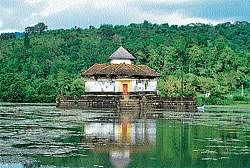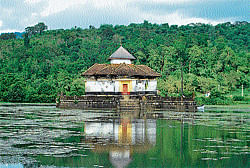

Here Basadi
“Neminath Basdi is almost 1200 years old and was built during the time of Varanga Raya, the ruler of Varanga”, says temple the priest. It is popularly called as Here Basadi meaning Big Basadi. The temple is 70 by 70 feet and has bronze idols of 24 Tirthanakaras in kayotsarg posture. The 5 feet black statue of Lord Neminath, the 22nd Tirthankara in padmasana position seating on ‘Kamala Peeta’ (lotus seat) is the main attraction of this temple, he says.
Kushmandini Devi, the Yakshi dedicated to Lord Neminath also called as Ambika Devi and idol of Yakshi Padmavati Devi is also present. Neminath Swami is considered as ‘Varanga Gramadevaru’ (Village God). According to an inscription dating back to 1424 AD, King Devaraya of Vijayanagar had left the Varanga village as a Datti (Granting land to a village to run a temple from the income generated).
There is a small shrine dedicated to Kshetra Pala outside the temple and it is believed that the temple is protected by Kshetra Pala. There is a 45 feet tall Manasthamba which is a symbol of a Jain temple. There are 4 Thirthankaras on the top of the pillar.
Kere Basadi
You can get rooted to the ground at the sight of Kere Basadi present amidst a pond which lies like a lotus in a lake. Said to be almost 850 years old and dedicated to Lord Parshwanath, the 23rd Tirthankara, the idol of Goddess Padmavathi, Yakshi of the deity is installed in front of the Parshwanatha idol.
The temple is a Chaturmukha Basadi with the Jain idols installed in four directions with four different entrances. It has the idols of Parshwanatha, Shanthinatha, Ananthanatha and Neminatha facing four different directions in Kayotsarga posture.
It is popularly believed that performing Poojas in this temple brings prosperity. Many people who intend to marry or who intend to take any new job or decision will perform pooja in this temple. It is said that if the deity is pleased with the match, a flower falls from the right side. Many people are sceptic to continue with the match or good work if the flower does not fall.
The only way you can reach this temple is in a small wooden boat. The temple remains closed most of the time and the priest takes the devotees to the temple on their request.
Chandranath Basadi
Chandranath Basadi is also called as Matada Basadi as it houses the Jain Mutt. The main deity is Chandraprabha who was the eighth Jain Tirthankar. The idol of the deity is made of Chandrashila and one could see the light across the idol. This 1,000-year-old idol is the main attraction of this Basadi.
History
The Jain Mutt is a branch of the Humcha Jain Mutt and is said to have belonged to the Mula Kundakundanvaya Kranurgana’s Mesha Pashana Gachha tradition. One of the inscriptions belonging to the 13th century found in the premises of the Neminath Basadi mentions about the existence of a Jain Mutt here even before the installation of the inscription. It is believed that the mutt ages back to the 8th or 9th century AD.
Festivals
The five-day Rathotsava that usually comes in the month of February is the main festival of this temple. The Puspha Rathotsava on the 3rd day and Maharathotsava on the 4th day are celebrated with pomp and the Thirthankara idols are put in the Rathas and taken for a ride during this festival. People pull the Puspha Rathotsava around the temple to fulfill their vows.
Bootha kola takes place during this festival. Navartri, Dasara, Deepavali are the other festivals celebrated in this Basadi. Commemorating the king’s procession during Vijayadashami, Padmavathi Devi is taken on palanquin on the Vijayadashami day.
How to reach
Take a bus that goes to Varanga through Karkala. If you are not able to get a direct bus, you can change buses from Karkala. It is about 70 kilometers from Mangalore, 43 kilometers from Moodabidri and 25 kilometers, that is, almost an hour away from Karkala.
Varanga is found on the way from Karkala to Agumbe.
Varanga is a small village and anyone can guide you to these Basadis. All the 3 Basadis are situated in the same premises. Request the temple priest who stays in a mutt near the temple to take you to Kere Basadi in a boat.